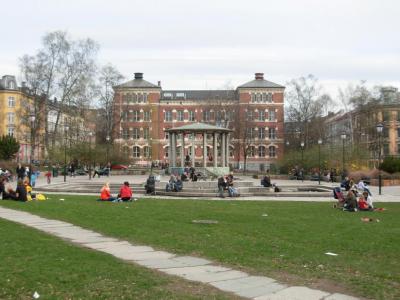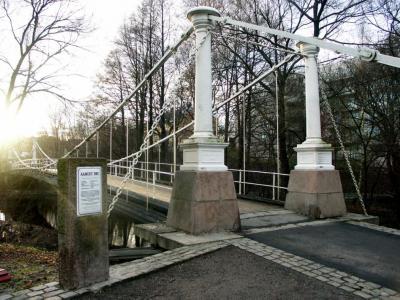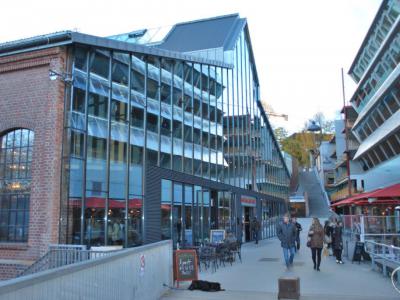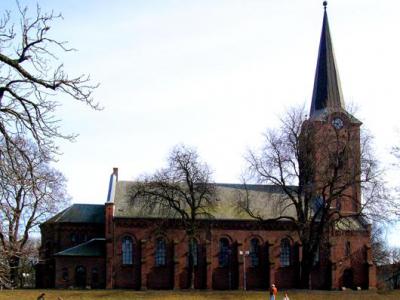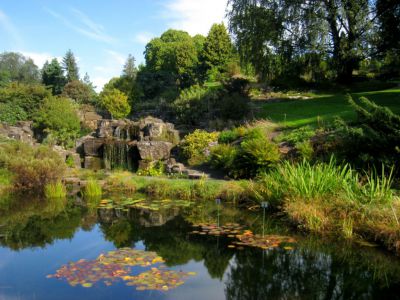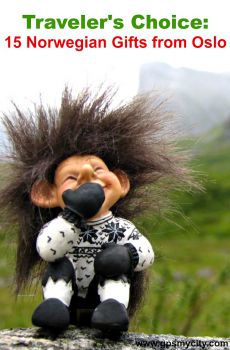
Grunerlokka Walking Tour (Self Guided), Oslo
Formerly a working-class area of Oslo, Grunerlokka is one of the capital’s hippest neighborhoods. This district is named after Friedrich Gruner, the former chief administrator of the city in the late 1600s. Today's Grunerlokka is a fusion of Norwegian and foreign cultures, owing it largely to the late 20th-century gentrification process.
Apart from the street art, stylish bars, happening dance clubs, and mellow cafes, there are plenty of cool places of interest in Grunerlokka worth checking out. Let's take a closer look at some of them.
Undoubtedly, one of the charming spots here is Birch Grove, a peaceful oasis where you can stroll amid beautiful trees, enjoying a serene escape from the city's hustle and bustle.
Dominating the city's skyline is the Paulus Church, a striking architectural landmark in Grunerlokka. This historic church stands as a symbol of the area's cultural heritage.
Aamot Bridge, on the other hand, is a functional structure connecting two sides of the neighborhood. It is also a picturesque spot from which to enjoy the scenic views of the Akerselva River running through the area.
Food enthusiasts will find much to their liking at the Mathallen Food Hall, offering a diverse range of culinary delights from around the world. It's a food lover's haven with an abundant choice – from gourmet cheeses to international street food.
The inviting green space of Sofienberg Park is ideal for picnics and relaxation, while the nearby historic Sofienberg Church adds its share of appeal to the neighborhood's cultural fabric.
The University Botanical Garden and the Natural History Museum are magnets for those keen on nature and science. Come here to explore the lush gardens and learn about the fascinating world of botany and natural history.
If you relish places with eclectic and artistic atmospheres, dynamic Grunerlokka may satisfy your interests in various areas, be it culture, nature, or gastronomy. So, plan your visit to this vibrant part of Oslo now!
Apart from the street art, stylish bars, happening dance clubs, and mellow cafes, there are plenty of cool places of interest in Grunerlokka worth checking out. Let's take a closer look at some of them.
Undoubtedly, one of the charming spots here is Birch Grove, a peaceful oasis where you can stroll amid beautiful trees, enjoying a serene escape from the city's hustle and bustle.
Dominating the city's skyline is the Paulus Church, a striking architectural landmark in Grunerlokka. This historic church stands as a symbol of the area's cultural heritage.
Aamot Bridge, on the other hand, is a functional structure connecting two sides of the neighborhood. It is also a picturesque spot from which to enjoy the scenic views of the Akerselva River running through the area.
Food enthusiasts will find much to their liking at the Mathallen Food Hall, offering a diverse range of culinary delights from around the world. It's a food lover's haven with an abundant choice – from gourmet cheeses to international street food.
The inviting green space of Sofienberg Park is ideal for picnics and relaxation, while the nearby historic Sofienberg Church adds its share of appeal to the neighborhood's cultural fabric.
The University Botanical Garden and the Natural History Museum are magnets for those keen on nature and science. Come here to explore the lush gardens and learn about the fascinating world of botany and natural history.
If you relish places with eclectic and artistic atmospheres, dynamic Grunerlokka may satisfy your interests in various areas, be it culture, nature, or gastronomy. So, plan your visit to this vibrant part of Oslo now!
How it works: Download the app "GPSmyCity: Walks in 1K+ Cities" from Apple App Store or Google Play Store to your mobile phone or tablet. The app turns your mobile device into a personal tour guide and its built-in GPS navigation functions guide you from one tour stop to next. The app works offline, so no data plan is needed when traveling abroad.
Grunerlokka Walking Tour Map
Guide Name: Grunerlokka Walking Tour
Guide Location: Norway » Oslo (See other walking tours in Oslo)
Guide Type: Self-guided Walking Tour (Sightseeing)
# of Attractions: 6
Tour Duration: 1 Hour(s)
Travel Distance: 2.5 Km or 1.6 Miles
Author: karen
Sight(s) Featured in This Guide:
Guide Location: Norway » Oslo (See other walking tours in Oslo)
Guide Type: Self-guided Walking Tour (Sightseeing)
# of Attractions: 6
Tour Duration: 1 Hour(s)
Travel Distance: 2.5 Km or 1.6 Miles
Author: karen
Sight(s) Featured in This Guide:
- Birch Grove
- Paulus Church
- Aamot Bridge
- Mathallen Food Hall
- Sofienberg Park and Church
- University Botanical Garden and Natural History Museum
1) Birch Grove
The Birch Grove (Birkelunden) is a serene park and verdant sanctuary nestled within the storied Grunerlokka district of Oslo.
Initially belonging to the Aker municipality until 1858, this area seamlessly became a part of Oslo. It was transformed into a park during the 1860s by Thorvald Meyer, a Norwegian entrepreneur and philanthropist. A key figure in the development of the Grunerlokka neighborhood, Meyer bestowed the park to the city in 1882. The landscape evolved with the addition of a music pavilion in 1926 and the creation of a small pool between 1927 and 1928. Noteworthy monuments, including one commemorating Norwegian volunteers in the Spanish Civil War, grace the park's grounds.
Encircled by historical edifices, many of which were erected during the 1870s and 1880s, The Birch Grove shares its borders with enduring structures. Adjacent to the park is the Grunerlokka School, which commenced operations in 1895, while on its western edge stands the Paulus Church, built in 1892.
In 2006, a comprehensive preservation effort was launched, encompassing the park, school, church, and fifteen blocks within the nearby urban expanse. Stringent regulations were enacted, preventing any visible alterations to the architectural fabric. Remarkably, this initiative, endorsed by the Norwegian Ministry of the Environment, marked the maiden instance of safeguarding a cultural milieu within an urban context.
The avenues enveloping The Birch Grove afford an ideal promenade, inviting individuals to amble and appreciate Oslo's historical architectural panorama.
Initially belonging to the Aker municipality until 1858, this area seamlessly became a part of Oslo. It was transformed into a park during the 1860s by Thorvald Meyer, a Norwegian entrepreneur and philanthropist. A key figure in the development of the Grunerlokka neighborhood, Meyer bestowed the park to the city in 1882. The landscape evolved with the addition of a music pavilion in 1926 and the creation of a small pool between 1927 and 1928. Noteworthy monuments, including one commemorating Norwegian volunteers in the Spanish Civil War, grace the park's grounds.
Encircled by historical edifices, many of which were erected during the 1870s and 1880s, The Birch Grove shares its borders with enduring structures. Adjacent to the park is the Grunerlokka School, which commenced operations in 1895, while on its western edge stands the Paulus Church, built in 1892.
In 2006, a comprehensive preservation effort was launched, encompassing the park, school, church, and fifteen blocks within the nearby urban expanse. Stringent regulations were enacted, preventing any visible alterations to the architectural fabric. Remarkably, this initiative, endorsed by the Norwegian Ministry of the Environment, marked the maiden instance of safeguarding a cultural milieu within an urban context.
The avenues enveloping The Birch Grove afford an ideal promenade, inviting individuals to amble and appreciate Oslo's historical architectural panorama.
2) Paulus Church
Situated in Grünerlokka, Oslo, Paulus Church stands opposite Birkelunden Park and dates back to its consecration in 1892. Constructed from brick, the church's design features front-cross arms and provides seating for around 500 individuals. Reflecting a German Gothic architectural style, the structure boasts a towering, slender spire above its east-facing entrance. The church's creation was envisioned by architect Henrik Bull in 1889, and subsequent renovations occurred in 1917 and 1972.
The church's exquisite altarpiece is crafted from brown-stained pine with delicate gold accents, divided into three distinct sections. Notable embellishments include trumpet angels masterfully crafted by Jo Visdalen, accompanied by two altar paintings by Christen Brun. Positioned between these artworks is a plaster Christ Figure, skillfully sculpted by artist Gunnar Olsen Alvær in 1894. The church's pipe organ, an integral part of its interior, was meticulously designed by German organ maker Albert Hollenbach for its consecration back in 1892.
The church's exquisite altarpiece is crafted from brown-stained pine with delicate gold accents, divided into three distinct sections. Notable embellishments include trumpet angels masterfully crafted by Jo Visdalen, accompanied by two altar paintings by Christen Brun. Positioned between these artworks is a plaster Christ Figure, skillfully sculpted by artist Gunnar Olsen Alvær in 1894. The church's pipe organ, an integral part of its interior, was meticulously designed by German organ maker Albert Hollenbach for its consecration back in 1892.
3) Aamot Bridge
The Aamot Bridge, situated in Oslo, Norway, is a suspension bridge designated for pedestrians. It spans the Aker River within the Grünerløkka district of Oslo.
Initially constructed over the Drammen River in Buskerud, near the convergence of the Simoa River at Åmot in Modum, the Aamot Bridge dates back to the years 1851–1852. The bridge was fashioned using cast iron chains produced at the Nes Jernverk. It stands as one of Norway's earliest examples of chain-hanger bridges.
Over time, due to deterioration, the Aamot Bridge was replaced by a newer structure and subsequently bequeathed to the city of Oslo. In 1952, the bridge underwent disassembly and was painstakingly relocated, piece by piece, to a fresh site along the Aker River. Originally intended as an entranceway to the Technical Museum planned for the Aker River location, the museum was eventually established elsewhere. Nowadays, the bridge solely accommodates cyclists and pedestrians.
An inscription adorns the bridge, serving as a cautionary message: "I can bear a hundred men, but falters during the rhythmic march."
Initially constructed over the Drammen River in Buskerud, near the convergence of the Simoa River at Åmot in Modum, the Aamot Bridge dates back to the years 1851–1852. The bridge was fashioned using cast iron chains produced at the Nes Jernverk. It stands as one of Norway's earliest examples of chain-hanger bridges.
Over time, due to deterioration, the Aamot Bridge was replaced by a newer structure and subsequently bequeathed to the city of Oslo. In 1952, the bridge underwent disassembly and was painstakingly relocated, piece by piece, to a fresh site along the Aker River. Originally intended as an entranceway to the Technical Museum planned for the Aker River location, the museum was eventually established elsewhere. Nowadays, the bridge solely accommodates cyclists and pedestrians.
An inscription adorns the bridge, serving as a cautionary message: "I can bear a hundred men, but falters during the rhythmic march."
4) Mathallen Food Hall
Mathallen Food Hall is the place to go for those who want a variety of dining choices. It's a good spot to sample different cuisines or to take a large group with varying appetites.
There are more than 30 shops and cafes where visitors can either dine in or enjoy al fresco eating thanks to plenty of outdoor dining.
Patrons can try choose from cuisines like Hungarian, Spanish, Southeast Asian, French, Italian and traditional Norwegian. There are also numerous places to purchase cheeses, dried meats, chocolates and drinks. There are also spots where visitors can buy food to sample now but save for later.
Mathallen Food Hall is open Tuesday through Sunday. The building rests on the banks of the Akerselva and within a short walk of Kuba Park. The pedestrian-friendly area is known for shopping and close proximity to music venue Vulkan Arena. It is also near the Kjaerlighetsstien Walking Trail, which is one of Oslo's many areas that highlight the joys of walking through the city.
There are more than 30 shops and cafes where visitors can either dine in or enjoy al fresco eating thanks to plenty of outdoor dining.
Patrons can try choose from cuisines like Hungarian, Spanish, Southeast Asian, French, Italian and traditional Norwegian. There are also numerous places to purchase cheeses, dried meats, chocolates and drinks. There are also spots where visitors can buy food to sample now but save for later.
Mathallen Food Hall is open Tuesday through Sunday. The building rests on the banks of the Akerselva and within a short walk of Kuba Park. The pedestrian-friendly area is known for shopping and close proximity to music venue Vulkan Arena. It is also near the Kjaerlighetsstien Walking Trail, which is one of Oslo's many areas that highlight the joys of walking through the city.
5) Sofienberg Park and Church
Sofienberg Park is a 180-acre park in northeast Oslo. The park's roots were not as a recreational structure at all but as a cemetery. It was established in 1858, but by the early 20th century the city grew to encompass the area and most of the graves were relocated to other cemeteries around the city. Out of 60,000 graves, only the Jewish Cemetery remains intact.
Sofienberg Park offers tennis tables and a playground. There are numerous picnic tables and many walking paths. One of the primary features of the park is Sofienberg Church.
The church, designed by architect Jacob Wilhelm Nordan, was consecrated in 1877. It is known for its beauty; especially the artistry of the altar and stained glass windows. The altarpiece was painted by Norwegian artist Otto Sinding. The stained glass windows were designed by painters Maria Vigeland and Enevold Thomt. Sofienberg Church is also a prominent concert venue due to its excellent acoustics.
Sofienberg Park offers tennis tables and a playground. There are numerous picnic tables and many walking paths. One of the primary features of the park is Sofienberg Church.
The church, designed by architect Jacob Wilhelm Nordan, was consecrated in 1877. It is known for its beauty; especially the artistry of the altar and stained glass windows. The altarpiece was painted by Norwegian artist Otto Sinding. The stained glass windows were designed by painters Maria Vigeland and Enevold Thomt. Sofienberg Church is also a prominent concert venue due to its excellent acoustics.
6) University Botanical Garden and Natural History Museum
The University Botanical Garden was founded in 1814 by the University of Oslo. The botanical garden contains more than 7,500 species of plants that are used for research and kept for conservation.
Included on the grounds of the University Botanical Garden are Toyen Manor and the Natural History Museum. Toyen Manor is home to roving exhibits and a cafe for visitors. It is the oldest building owned by the University of Oslo and thought to be the oldest wooden building in the city.
The Natural History Museum is the largest such museum in the country. The indoor exhibitions include history dioramas, minerals, fossils and the world's oldest complete primate skeleton. The Climate House is a part of the Natural History Museum that aims to educate patrons about climate change.
The University Botanical Garden and Natural History Museum are located in Toyen Park, west of the Edvard Munch Museum. Tourists can visit the botanical gardens free of charge any day of the week. All exhibits are free on Thursdays.
Included on the grounds of the University Botanical Garden are Toyen Manor and the Natural History Museum. Toyen Manor is home to roving exhibits and a cafe for visitors. It is the oldest building owned by the University of Oslo and thought to be the oldest wooden building in the city.
The Natural History Museum is the largest such museum in the country. The indoor exhibitions include history dioramas, minerals, fossils and the world's oldest complete primate skeleton. The Climate House is a part of the Natural History Museum that aims to educate patrons about climate change.
The University Botanical Garden and Natural History Museum are located in Toyen Park, west of the Edvard Munch Museum. Tourists can visit the botanical gardens free of charge any day of the week. All exhibits are free on Thursdays.
Walking Tours in Oslo, Norway
Create Your Own Walk in Oslo
Creating your own self-guided walk in Oslo is easy and fun. Choose the city attractions that you want to see and a walk route map will be created just for you. You can even set your hotel as the start point of the walk.
Oslo Introduction Walking Tour
Oslo is the capital of Norway. The name "Oslo" means the field below the hill or the field of the Gods. The city's ancient roots can be traced as far back as the year 1000. Back then, the area was known as Viken. By 1300, it had a population of about 3,000 residents. Around that time, King Haakon V ordered the construction of the Akershus Fortress which today is a major city... view more
Tour Duration: 2 Hour(s)
Travel Distance: 4.1 Km or 2.5 Miles
Tour Duration: 2 Hour(s)
Travel Distance: 4.1 Km or 2.5 Miles
Historical Churches Walking Tour
Oslo's religious landscape, particularly within the Christian tradition, is a captivating tapestry interwoven with history, faith, and architectural elegance. The city boasts a collection of historical churches reflecting the evolution of local Christian communities. Diverse in their designs, these sacred sites offer a glimpse into the deep-rooted religious traditions that have shaped Oslo... view more
Tour Duration: 1 Hour(s)
Travel Distance: 2.0 Km or 1.2 Miles
Tour Duration: 1 Hour(s)
Travel Distance: 2.0 Km or 1.2 Miles
Museum District (Bygdoy) Walking Tour
Oslo's Museum District, located on the Bygdoy Peninsula, is home to some of the most visited museums in the city. Repositories of precious artifacts from Norway’s history, these remarkable institutions collectively represent a treasure trove for those keen on exploring this northerly nation's past.
One of the standout attractions here is the Fram Museum, showcasing the incredible... view more
Tour Duration: 2 Hour(s)
Travel Distance: 3.1 Km or 1.9 Miles
One of the standout attractions here is the Fram Museum, showcasing the incredible... view more
Tour Duration: 2 Hour(s)
Travel Distance: 3.1 Km or 1.9 Miles
Old Oslo Walking Tour
The historic Old Town of Oslo is the oldest part of the city which dates back to the days of medieval Norway. This urban area emerged around the year 1000 and became the capital of Norway's dominion (within the Dano-Norwegian Realm) around 1300. The Old Town district continued to be known as Oslo, while the whole city was called Christiania, until 1925.
One of its prominent landmarks is... view more
Tour Duration: 1 Hour(s)
Travel Distance: 1.4 Km or 0.9 Miles
One of its prominent landmarks is... view more
Tour Duration: 1 Hour(s)
Travel Distance: 1.4 Km or 0.9 Miles
Useful Travel Guides for Planning Your Trip
Traveler's Choice: 15 Norwegian Gifts from Oslo
The Norwegians are strict about gift making and believe that each gift must be equaled with a return one. For this reason, public holidays and birthdays are a very serious business in Norway, with everyone making and receiving gifts. In the spirit of this tradition, you might want to treat your dear...
The Most Popular Cities
/ view all
